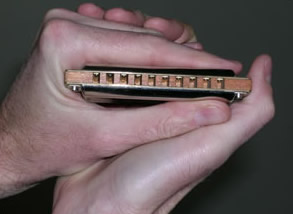Got yourself a blues harp but don’t know what to do with it? Well, assuming you are naturally right handed and purse your lips when you try to play, here’s how to get started.
Holding your harmonica
You’ll notice the numbers 1 to 10 are printed on one side of your harmonica. These relate to each of the 10 holes. Hold the harp in your left hand, in the apex between your thumb and forefinger, numbers on top. Your index should ideally run along the ridge at the back of the upper cover plate, so you can see plenty of metal and all the numbers with room to spare.
 The outer curve of your left thumb should fit nicely onto the ball of your right thumb (see image). I call this the ‘hinge’. Now cup your right hand around the back of the harp to form a chamber. This is the classic hand hold.
The outer curve of your left thumb should fit nicely onto the ball of your right thumb (see image). I call this the ‘hinge’. Now cup your right hand around the back of the harp to form a chamber. This is the classic hand hold.
In the image, the right thumb is hooked around the top end of the harp. This is an ideal hand hold for digging into those lower notes and bends. Keeping the hinge connected, you can rotate your right hand however you want to open up the back of the harp and project notes, or use a hand vibrato or wah wah. Try it out and see what’s comfortable.
Making a noise
Most important: don’t literally blow and suck! We use these terms loosely, but this is not exactly how we play. We actually breathe the notes from the diaphragm. Exhale normally for the blow notes and inhale normally for the draw notes. No need to blast it either way.
And try not keep those lips too rigid. Loosen up! Make sure the harp is right in between your lips so that the wet inner parts of your lips touch the metal cover plates forming an airtight seal. Ideally you will be covering the numbers with your lips and knuckle of your left index finger will be resting against your philtrum (the bit just under your nose your mum was always wiping when you were a kid). You should be embracing the harp, rather than addressing it with tightly pursed lips.
You don’t want any air escaping out of the corners of your mouth. To adjust accordingly. Now relax your embouchure (chops) a little with your mouth slightly open and covering the lower three or four holes. Now breath out gently. Don’t try and blow the stuffing out of it. Gently does it. Now try the same breathing in. It should sound like this:
Keep an ear out for any peripheral hissing or whooshing sounds. These are telling you your chops are not air-tight. So try adjusting to eliminate the leaks. A good seal is essential when working on your next two goals.
First goals
Well done! You can make a noise. That wasn’t too hard was it? Now the serious work begins. Your first two goals are developing accuracy and tone. Accuracy is all about individual note playing. Tone is all about building the sound quality of your note playing. Check out the linked pages for more information.

